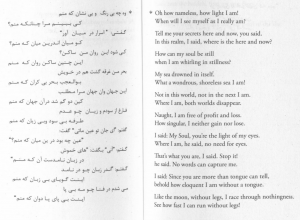Ghazals and Miniatures (Week 9)
April 8th, 2014
This week in class and in section we discussed the romantic poetry of the ghazals. This originally secular form of poetry was adopted into Sufi mysticism as a means of expressing devotion and love to Allah. I really enjoyed the different poems we read for class and was especially excited to learn more about the context of the poems of the Iranian mystic poet, Rumi, that I love. I then looked up a few of his ghazals and found both the Persian and English translation of “Oh how nameless, how light I am!” in Say Nothing: Poems of Jalal al-Din Rumi in Persian and English , the text of which is shown below:
I really enjoyed this poem because I feel like it is quite representative of the themes of nothingness and emptiness that are so prominent in Rumi’s work. This motif can be analyzed also in the context of religion with regards to the stillness that is necessary for the acceptance of God but emptiness that yearning for the love of God. I also really enjoy the use of water in the imagery, that represents the purity and fluidity of life.
Inspired by our recent trip to the Met, I wanted to create something in the style of the miniatures we saw that illustrated Hafiz’s poems for this ghazal by Rumi. Here is a picture of the final creation:
I remembered Professor Asani specifically pointing out the detail put into not only the main focus, but into the borders that surround it. And I personally noted the use of metallic colors for decoration in many of the pieces. For the background, I wanted to select something that would be as delicately radiant as the backgrounds of the miniatures. However, I personally do not have the ability to create the detailed floral geometric patterns that decorated the edges, so I was able to procure a shiny background.
The layout of the work is reminiscent of the binding of a book for a manuscript. On the left is the text of the poem. I tried my hand out at writing out the Persian script, carefully trying to align it into two columns as is traditionally seen in poetry, especially ghazals. However, this was difficult and sometimes I ran out of room, so I also employed one of the artistic aspects of the works I noticed in the Met. In some of the Qur’an manuscripts there were metallic circles, which the descriptions stated were used to denote the breaks of phrases and sections. Therefore, I included my own metallic star shapes (as the star is common in Islamic art) to denote the phrase breaks within the text.
On the right is a drawing done in the style of the miniatures. This is seen in the overall technique with the use of black outline and bright, contrasting, solid colors along with metallic highlights, seen specfically in the stars, border, and jewels. First and foremost is the female figure, who is clad in South Asian dress but also has the moon-shaped face and facial features that are seen as signs of beauty in the miniature paintings. Additionally, there are other symbols such as the fire halo around the pearl to demonstrate its divinity. And, relating back to the poem, the background of blue with white waves showcases a blend between the water and the sky, demonstrating the turmoil in the persona of the poem in being “drowned” in love and wonder and longing.




Leave a Reply